![]()
![]()
![]()
Use LEFT and RIGHT arrow keys to navigate between flashcards;
Use UP and DOWN arrow keys to flip the card;
H to show hint;
A reads text to speech;
65 Cards in this Set
- Front
- Back
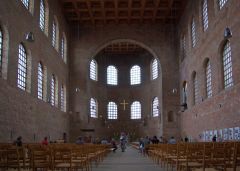
|
Aula Palatina,Trier
Trier, Germany 300 -basilica-like -boring outside -look down the long interior, heightens drama -when you enter church you enter the realm of God -exterior intentionally boring |
|
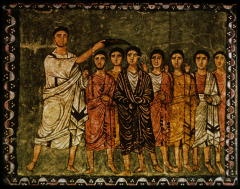
|
Samuel Anoints David, Detail of the Main Interior Wall of the Synagogue
Dura-Europos, Syria ca. 245-256 Tempera of Plaster -the prophet anoints the future king of Israel -David's six older brothers watch -drew attention to Samuel by drawing him larger than everyone else -seem weightless -bodies don't even have enough feet -David stands out, wearing a purple toga, purple is the color of Roman emperor -flattening out of figures -no shading or detail -loss of background details |
|
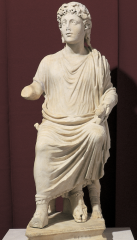
|
Christ Seated
Civita Latina, Italy Marble ca. 350-375 -Christ is a long haired man dressed in a simple tunic -seated in a position that Roman emperors occupy -flowing hair like Apollo -dressed like a senator -holding a scroll like a philosopher |
|
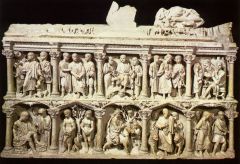
|
Sarcophagus of Junius Bassus
Rome, Italy ca. 359 Marble -grew up polytheistic and converted to Christianity -front has 10 scenes -Jewish and Christian biblical stories fill the niches -Jesus appears in the center of each -Include scenes of Adam and Eve -Crucifixion doesn't appear, rare in Early Christian art -Artists emphasized Jesus' divinity and teachings, not suffering and death at the hands of the Romans -top panels centered around Jesus -recycling roman visuals but plugging in Christianity |
|
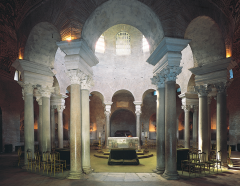
|
Interior of Santa Costanza
Rome, Italy ca. 337-351 -central-plan building (the parts are of equal or almost equal dimensions around the center) -possibly built for Constantina, the emperor's daughter -housed her sarcophagus -later converted into a church -domed -Constantine's daughter -round -ambulatory, place to walk around the church in a cirlce -bland exterior -inside is like the Heavens open up |
|
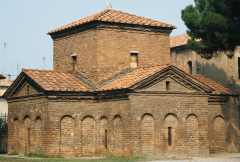
|
Mausoleum of Galla Placidia
Ravenna, Italy ca. 425 -probably originally a chapel to Saint Lawrence -once thought to be the tomb of Galla Placidia (Honrius' half-sister) -cruciform chapel with a domed crossing -early example of the combination of central and longitudinal plans -mosaics everywhere inside -plain exterior -central tower with windows, cast light |
|
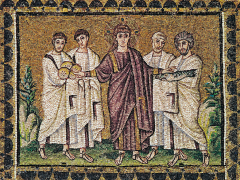
|
Miracle of the Loaves and Fishes, Mosaic from the Top Register of the Nave Wall of Sant' Apollinare
Nuvo, Ravenna, Itlay ca. 504 -Jesus has a halo -facing directly toward the viewer -extended arms direct his disciples to distribute the bread and fish to the crowd -quest for perfection of the body is replaced by quest for getting most significance out of a piece, if that means there is weird twisting of the body then that is okay |
|
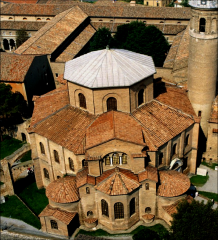
|
San Vitale
Ravenna, Itlay 526-547 -dedicated to Saint Vitale who died a martyr -centrally planned church -clerestory lighting -a lot of arches -everything seems to change based on the viewers perspective -mosaic represents dual religious and political roles of the Byzantine emperor -unlike other Early Christian churches, it is not a basilica -features a dome-covered clerestory-lit central space defined by piers alternating with curved, column exedrae, creating an intricate eight-leafed plan |
|

|
Justinian as world conquerer (Barberini Ivory)
Rome, Italy 550 Ivory -panel carved in five parts -center is the emperor, Justinian -a startled barberini recoils in fear behind him -motif dynamic twisting posture of horse and rider -motif of spear-thrusting equestrian emperor -both are familiar motifs in Roman imperial works -personifications of bountiful Earth and pal-bearing Victory -source of the emperor's strength is God -Christ blesses Justinian -Justinian riding a horse and squishing a woman beneath him, the woman might represent land, he might be conquering land |
|
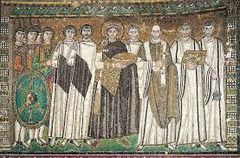
|
Justinian, Bishop Maximianus, and attendants, mosaic on the North Wall
Ravenna, Italy ca. 547 -emperor is at the center -distinguished by his purple robe and halo -on the right is Bishop Maximianus -labeled in the mosaic to show his importance -he was the one responsible for the completion of San Vitale -figures divided into three groups: emperor and staff, clergy and imperial guard -each group has a leader -emperor seems to be slightly behind the bishop -this shows that the imperial and churchly powers are in balance -soldiers have the symbol of Jesus on their shield |
|

|
Transfiguration of Jesus, apse mosaic in Church of the Virgin,
Monastery of Saint Catherine, Mount Sinai, Egypt ca. 548-565 -Jesus appears in a deep-blue almond shaped mandorla (almond-shaped aurole of light) -at his feet are John, Peter and James -at the left and right are Elijah and Moses -rays stream down from Jesus onto the desciples -eternal composure of heavenly beings compared to the distraught responses of the earthbound -nothing to suggest the passing of time or motion through physical space -eternal and motionless world of religious truth -when he goes up on a mountain and reveals his divinity to his apostles -everything is holy and timeless -the closer we get to Jesus the more we can only see Jesus -Jesus' holiness is hitting each one of the apostles |
|
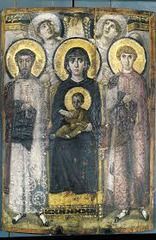
|
Virgin (Theotokos) and Child between Saints Theodore and George
Icon, Encaustic on wood 550-600 Monastery of Saint Catherine, Mount Sinai, Egypt -icons: small portable paintings depicting Christ, figured prominently in private devotion -wood used for this icon -two guardian saints intercede with the Virgin on the viewer's behalf -two angels gaze upward to a shaft of light where the hand of God appears -the saint's bodies are in the new Byzantine manner -figures seem to float in space -very formal, more 3D than later pieces |
|

|
Katholikon (exterior and interior)
Hosios Loukas, Greece 1025 -dome on a drum -starting to decorate the outside of the church too -light stones framed by dark brick -dome placed over an octagon inscribed within a square -interest in livening up the exterior -breaking up the space, alternating colors, lights and shadows |
|
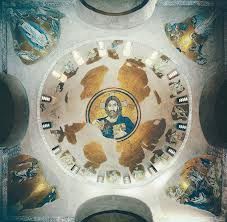
|
Interior of the Church of Dormition (looking into the dome)
Daphni, Greece ca. 1090-1100. -interior creates mystery out of space, surface, light and dark -forces viewers gaze to look up -dramatically shifting perspectives |
|
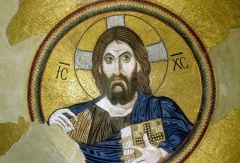
|
Christ as Pantokrator, dome mosaic in the Church of the Dormition
Daphni, Greece ca. 1090-1100 -Pantokrator means "ruler of all" -like a giant icon hovering dramatically in space -serves to connect the awestruck worshiper in the church below with Heaven through Christ -timeless and glorious -motionless and unchanging -no longer a youth, sagging and older, you can see the suffering -by sharing in his suffering you draw close to him |
|
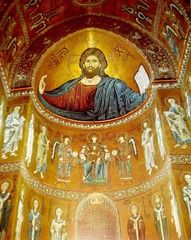
|
Pantokrator, Theotokos and Child, angels, and saints, apse mosaic in the cathedral
Monreale, Italy ca. 1180-1190 -this church is a basilica -put the Pantokrator in the semidome because there is no full dome -flanked by angels and the 12 apostles |
|
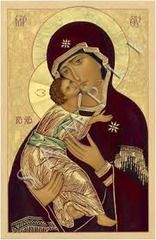
|
Virgin of Compassion icon (Vladimir Virgin)
1050-1100, with later repainting Tempera on Wood -most renowned middle Byzantine icon produced in Russia -has the typical characteristics of the virgin and child on icons: Virgin has a long nose and small mouth, child dressed in gold, seem to be one figure not two, -cheeks pressed together, makes this very intimate -symbol of the Byzantium's religious and cultural mission to the Slavic world |
|

|
ANDREI RUBlYEV
Three Angels (Old Testament Trinity) ca. 1410 Tempera on Wood -Russian painting reached a climax in the work of Andrei Rublyev -three angels sitting around a table -distinguished solely by their clothing -most likely the depiction of the Father, son and Holy Spirit -not sure which one is which |
|

|
Dome of the Rock
Jerusalem 687-692 -marked the coming of the new religion to the city -previously Jewish and Christian -is thought to be the location of Adam's grave where Abraham prepared to sacrifice Isaac -the giant rock is also thought to be the place where Muhammad began his journey to Heaven and returned to Mecca in the same night -domed central plan -very similar to old churches in the design -octagon, dome, drum |
|

|
The Great Mosque
Kairouan, Tunisia ca. 836-875 -one of the best preserved early mosques -hypostyle design -resembles Roman forum -modeled on the house of the prophet |
|
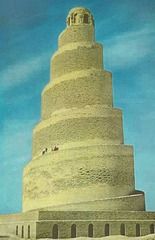
|
Malwiya Minaret, Great Mosque
Samarra, Iraq 848-852 -more than 165 feet tall -originally there was a bridge that connected it to the mosque -was used by Muslims for the call of prayer -not very practical |
|
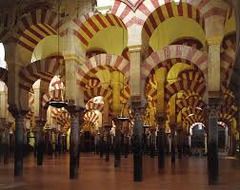
|
Prayer Hall of the Mezquita (Great Mosque)
Córdoba, Spain 700-900 -36 piers and 514 columns -double tiered arches that carried a wooden roof -horseshoe arch became quickly associated with Muslim architecture -Muslims are trying to overwhelm our senses |
|
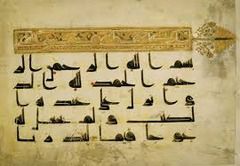
|
Koran page with beginning of surah 18
800-900 Ink and gold vellum -red dots indicate vowels -Kufic style -very angular -has a palm tree finial -fluid script -allows for decorative script, unlike English |
|
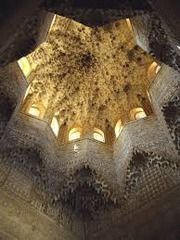
|
Muquarnas dome, Hall of the Abencerrajes, Palace of the Lions
Alhambra, Granada, Spain 1354-1391 -elaborate stucco ceilings -dome rests on octagonal drum supported by squinches -eight pairs of windows -structure is difficult to discern because of the stucco -Muqarnas- tier after tier of stalactite-like prismatic forms that seem aimed at denying the structure's solidity -Muqarnas catch and reflect the light and create patterns -changing the architecture with decoration -palace walls bear inscriptions with verses by the court poet Ibn Zamrak |
|
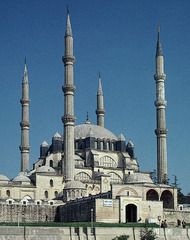
|
SINAN
Mosque of Selim II (Exterior) Edrine, Turkey 1568-1575 -Sinan was the court architect -had been the capital of the Ottoman Empire from 1367-1472 -four slender minarets offset the massive dome -new type of mosque with dome-covered square prayer hall -taller than the Hagia Sophia -almost looking at the Hagia Sophia and saying they can make a better one |
|

|
SINAN
Mosque of Selim II (Interior) Edrine, Turkey 1568-1575 -mihrab is recessed into an apselike alcove -allows for windows on three sides -windows allow the tiles to be illuminated -octagon formed by 8 massive dome supports is pierced by 4 half-dome-covered corners of the square -ratio of 1:2 -very geometric and fluid |
|
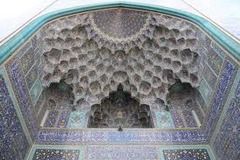
|
Muqarnas tilework of the entrance portal of the Imam (Shah) Mosque
Isfahan, Iran 1611-1638 -tiles cover almost every surface -had to manufacture very specific shapes -tiles used so that they reflect light -cuerda seca tiles, allowed for more complex vegetal patterns |
|

|
Mihrab, from the Madrasa Imami
Isfahan, Iran ca. 1354 Glazed mosaic tilework -perfect aesthetic union between the Islamic calligrapher's art and abstract ornamentation -has an inscription from the Koran in Kufic around the pointed arch -Muhaqqaq is the the cursive style of script -fills the outer frame -in between arch and frame is an abstract floral motif -every piece had to b cut specifically, even the letters |
|
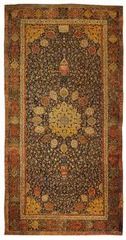
|
MAQSUD OF KASHAN
Carpet from the funerary mosque of Shaykh Safi al-Din Ardabil, Iran 1540 Wool and silk -Maqsud must be the artist who supplied the master design for the carpet -carpet weaving was a national industry -set up royal factories -supposed to look like a pool of water reflecting a lamp with flowers floating in the water -no human figures because it was meant to be for a mosque |
|
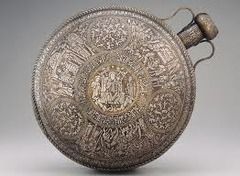
|
Canteen with episodes from the life of Jesus
From Syria ca. 1240-1250 Brass, inlaid with silver -Christian tourism to Islamic lands was very common during the 11th through 13th centuries -Created pieces with Christian works for the tourists -three scenes from the life of Jesus appear in counterclockwise sequence |
|
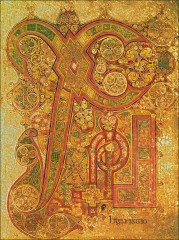
|
Chi-rho-iota (XPI) page, folio 34 recto of the Book of Kells
Probably from Iona, Scotland 750-800 Tempera on vellum 1'1" x 9 1/2" -page that opens the account of the nativity of Jesus in the Gospel of Saint Mathew -XPI are the initial letters of Christ in Greek -the letters in the corner read "Now this is how the birth of Christ came about" |
|
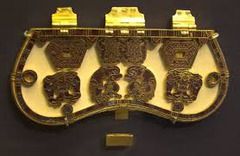
|
Purse cover, from the Sutton Hoo ship burial
Suffolk, England ca. 625 gold, glass, and cloisonné -found in a ship -early medieval tradition of burying great lords in ships with rich furnishings -cloisonné technique of putting semiprecious stones in metal -cross between mosaic and stained glass -on the lower sides is a man standing between two animals -in the middle are eagles attacking ducks |
|
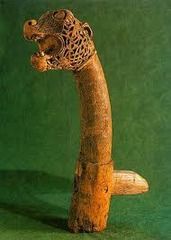
|
Animal-head post, from the Viking ship burial
Oesburg, Norway ca. 825. Wood Head 5" high -decoration on a ship -ship must have once contained many precious objects that robbers must have stolen -protruding eyes and flared nostrils |
|
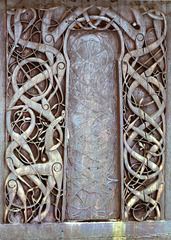
|
Wooden portal of the stave church
Urnes, Norway ca. 1050-1070 -stave: wedge-shaped timbers placed vertically -gracefully elongated animals intertwined with |
|
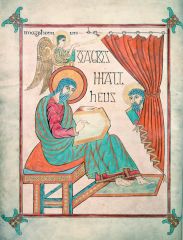
|
Saint Mathew, folio 25 of the Lindisfarne Gospels
From Northumbria, Engalnd ca. 698-721 Tempera on vellum -artist based their composition on classical pictures in imported Mediterranean books -seated philosophers or poets writing or reading were very common -The Lindisfarne Mathew sits in his study composing his account of the life of Christ -the curtain indicates that it is indoors -seat is at an angle which indicates a Mediterranean model employing classical perspective -Mathew is labeled in a combination of Greek and Latin -Mathew's symbol is a winged man, he appears right above Mathew's head -not sure who the man behind the curtain is, could be Christ, Saint Cuthbert or Moses -folds on his outfit are regular and flat |
|
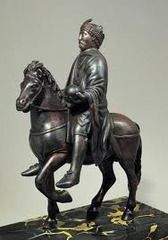
|
Equestrian portrait of Charlemagne or Charles the Bald
From Metz, France 800 Bronze, originally gilt -first Germanic ruler of Rome -model for this statue was the equestrian statue of Marcus Aurelius -made Charlemagne large so that the focus is on him and not the horse -wearing imperial clothing instead of a general's cloak -holding a globe in his outstretched hand, symbol of world domination -proclaimed the renovatio of the Roman Empire's power and trappings |
|
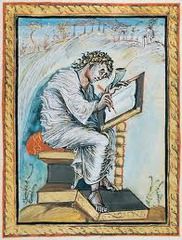
|
Saint Mathew, folio 18 verso of the Ebbo Gopsels (Gospel Book of Archbishop Ebo of Reims)
From Hautvillers, France ca. 816-835 Ink and tempera on vellum -Saint Mathew -Gospel book made for Archbishop Ebbo of Reims, France -winged man in the upper right hand indicates that it is Saint Mathew -writing hastily -the landscape behind him is very alive -his face, hands and inkhorn/pen are the focus of the painting -merged classical illusionism with the northern European linear tradition - |
|
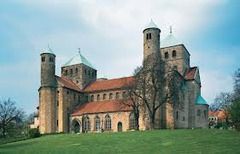
|
Saint Micheal's (looking northwest)
Hildesheim, Germany 1001-1031 -Bishop Bernward was the builder -double transept plan -six towers and a westwork -two transepts create eastern and western centers of gravity -nave seems like it is just a hall connecting the two -traditional basilica style is almost completely lost |
|

|
Otto III enthroned, folio 24 of the Gospel of Otto III
From Reichenau, Germany 997-1000 Tempera on vellum -shows Otto III, the son of Otto II -enthroned and holding a scepter and cross-inscribed orb -this signifies his universal authority -beside him are the clergy and the barons (the Church and the state) -Otto III was very concerned about reviving the Christian Roman Empire -moved his court to Rome |
|

|
GISLEBERTUS
Last Judgement, west tympanum of Saint-Lazare Autun, France ca. 1120-1135 -his intentions were to scare the Christian people into being good and not sinning -many illiterate people, they didn't need to read the inscription in order to understand the message, message says that you should repent otherwise you will suffer like some of the people in the piece -Christ is the largest figure -the people on the left are waiting to be judged, an angel boosts one into heaven -the bottom souls of the dead await their fate -on the bags of two of the men are a cross and shell, the symbols of pilgrims to Jerusalem -on the right are those going to Hell -above souls are being weighed -on the far right are demons taking people and shoving them into a furnace -Romanesque |
|
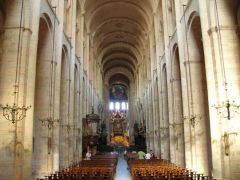
|
Interior of Saint-Sernin (looking east)
Toulouse, France ca. 1070-1120 -increased nave length -doubled side aisles -added transept, ambulatory and radiating chapels for more room -geometrically precise -ratios used in the building -tribunes opening into the nave -these tribunes helped to house more people and distribute the weight to support the groin vault -identical vertical columns running along the sides of the church give the illusion of length |
|
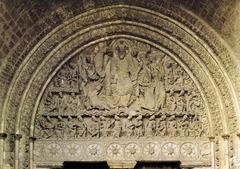
|
South Portal of Saint-Pierre
Moissac, France ca. 1115-1135 -the Second Coming of Christ -Christ is the king and judge of the world in its last days -four evangelists flanking Christ -angels holding scrolls to record human deeds for judgement -24 musicians all facing towards Christ ready to play him music when he wishes -Christ is larger than everyone else |
|
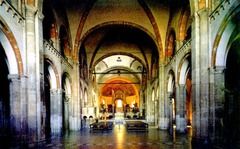
|
Interior of Sant' Ambrogio (looking East)
Milan, Italy 1050-1100 -nave and two isles, no transept -groin vaults -windows in the dome provide a lot of lighting compared to the rest of the dark church -"dome of Heaven" -no clerestory -rib vaulting |
|
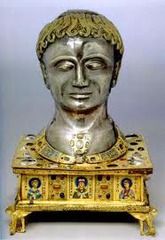
|
Head reliquary of Saint Alexander, from the abbey church
Stavelot, Belgium 1145 Silver repoussé (partly gilt), gilt bronze, gems pearls and enamel -Churches competed to have the best relics, economic draw, people come to see the relics -idealized head -wearing a collar of jewels and enamel plaques around his neck -enamel and gems on the box -box rests on four bronze dragons -life sized head -combination of idealized classical head with Byzantine-style enamels |
|
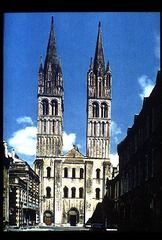
|
West facade of Saint-Étienne
Caen, France begun in 1067 -four large buttresses -the buttresses divide the church into three sections, this corresponds to the nave and the aisles -the spires are a later Gothic addition -groin vaulting -clerestory windows -interior is lighter with the clerestory -rub vaulting -light and airy, strange for Romanesque |
|
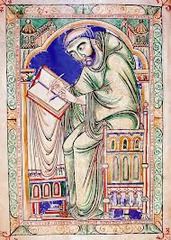
|
EADWINE THE SCRIBE
Eadwine the Scribe at work, folio 283 verso of the Eadwine Psalter Normandy, England ca. 1160-1170 Ink and tempera on vellum -Eadwine was a monk -this illustration shows Eadwine at work, writing and scraping -drapery falls more softly and follows the movements of the body -patterning is still prevalent -swirls and patterning on his cloak -heavy exterior lines and light inner lines -Eadwine made himself seem great by making the picture like that of an Evangelist writing his gospel -also inscribed "prince among scribes" |
|

|
Bayeux Tapestry, from Bayeux Cathedral
Bayeux, France ca. 1070-1080 Embroidered wool on linen -real and imaginary animals make up the border -friezelike, tells the narrative of a crucial moment in England's history and the events leading up to it -Normans took over England and France -probably made soon after the Normans took power -first part of the tapestry depicts King Edward's funeral procession -the hand of God point the way to the church -the details of the church, one of the first Romanesque in England, are shown -the second part is the Battle of Hastings -Normans are killing the English defenders -the dead fill the lower border -horses with twisted bodies, throwback to Greco-Roman style |
|
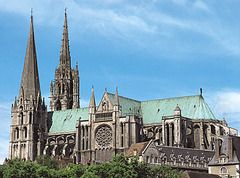
|
Chartres Cathedral
Chartres, France Rebuilt after 1194 -rib vaults -flying buttresses -dedicated to the virgin Mary -destroyed in a fire before it had been completed -reconstruction but in the High Gothic style |
|
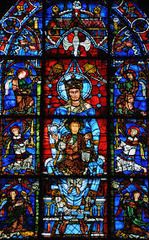
|
Virgin and Child and angels (Notre dame de la Belle Verriere) detail of a window in the choir of Chartres Cathedral
Chartres, France ca. 1170, 13th century side panels Stained glass -depicts the Virgin Mary enthroned with the Christ Child in her lap -Mary is the queen of Heaven -dove of the Holy Spirit at the top -Gothic and Byzantine builders used light to transform the material world into the spiritual -survived a fire |
|
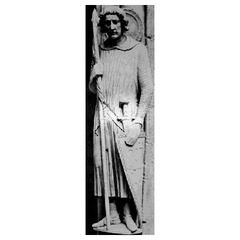
|
Saint Theodore, jamb statue, left portal, Porch of the Martyrs, south transept, Chartres Cathedral
Chartres, France ca. 1230 -portrayed Theodore as the ideal Christian knight -clothed in chain-mail and cloak of 13th-century crusaders -hip swung to the right -very similar to Greek statuary of the idealized man with contrapposto stance -tense and relaxed in counterbalance -following what early Greeks did -going from classical and formal to more natural |
|
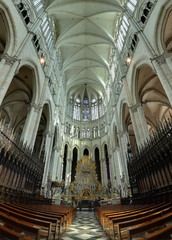
|
ROBERT DE LUZARCHES, THOMAS DE CORMONT and RENAUD DE CORMONT
Interior of Amiens Cathedral Amiens, France 1220 -proportions are more slender -four-part rib vault -buttresses -more slender supports than earlier works -increasingly taller buildings -seems very light and airy -decorated the small spaces that were left |
|
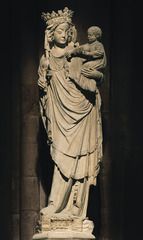
|
Virgin and Child (Virgin of Paris)
Notre-Dame, Paris, France 1300 -exaggerated S curve -pictured as a queen -wearing a very detailed crown -Christ reached toward his mother -humanization of the portrayal of religious figures in Gothic sculpture -Mary and Jesus are linked to the royalty of France -baby Jesus often dressed like a prince |
|

|
VILLARD DE HONNECOURT
Figures based on geometric shapes, folio 18 verso of a sketchbook Paris, France ca. 1220-1235 Ink on vellum -shows how both natural forms and buildings are based off of basic geometry |
|
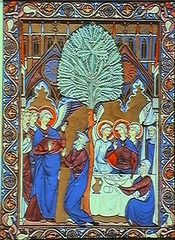
|
Abraham and the Three Angels, folio 7 verso of the Psalter of Saint Louis
Paris, France 1253-1270 Ink, tempera and gold leaf on vellum -produced for Louis IX -reminiscent of stained glass windows -two different episodes depicted, separated by the tree -on the left Abraham greets the three angels -on the right he entertains the angels while his wife watches from a tent -elegant proportions, facial expressions, theatrical gestures and swaying poses -S curve, bringing it back to Greek art |
|
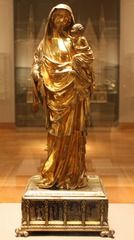
|
Virgin of Jeanne d'Evreux, from the abbey church of Saint-Denis
Denis, France 1339 silver gilt and enamel -French queen donated this to the church -Mary stands on a decorated base with scenes form Christ's passion -Christ reaches for his mother -swaying posture -heavy drapery folds -humanization of the figures -holding the Fleur-de-lis, a French political symbol -bridging their rule on Earth with Mary's rule in Heaven -showing Mary favors France |
|
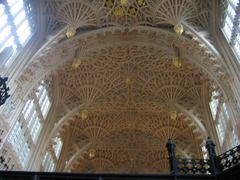
|
ROBERT AND WILLIAM VERTUE, fan vaults of the chapel of Henry VII
Westminster Abbey, London, England 1503-1519 -turned vaulting into a sort of embroidery -this style is called fan vaulting -looks like an organic pattern -radiating ribs forming a fanlike pattern |
|
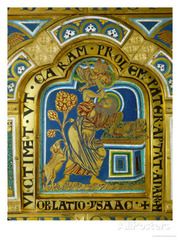
|
NICHOLAS OF VERDUN
Sacrifice of Isaac, detail of the Klosterneuburg Altar Klosterneuburg, Austria 1181 Gilded copper and enamel -twisted bodies -intricate linear folds of drapery -figures stand out from the dark blue background -using metal and filling the spaces with powdered glass, enamel -the sacrifice of Isaac by Abraham -Angel stops him before he kills Isaac, instead he is told to use a goat by an angel -twisting and turning -drapery, realistic folds -different colors to create depth -face, intensity of emotion |
|
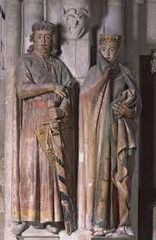
|
NAUMBURG MASTER
Ekkehard and Uta, statues in the west choir Naumburg Cathedral, Nauburg, Germany ca. 1249-1255 Painted limestone -statues of donors -Ekkehard was the military governor -more separated from the jamb than older statues -intense knight Ekkehard contrasts with beautiful and aloof Uta -images of real people in churches |
|
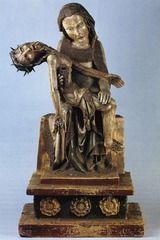
|
Rottgen Pieta
Rhineland, Germany ca. 1300-1325 Painted wood -Virgin Mary holding Christ in her lap -humanizes biblical figures -human emotions -apparent suffering in Christ's face and anguish in Mary's -very different from Romanesque statues -tells the viewer "what is your suffering compared to this" -this was a bad time for Europe and reminds the people that were suffering during that time that their suffering is nothing compared to Mary and Jesus |
|
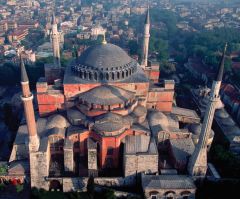
|
ANTHEMIUS OF TRALLES and ISIDORUS OF MILETUS
Aerial view of Hagia Sophia (looking west) Constantinople (Istanbul), Turkey 532-537 -Justinian built this, he was an ambitious builder -Byzantine -this was built after a previous church was destroyed in a fire -Justinian wanted this church to bigger and better than all other churches -very large and grand structure that did set the standard for churches -buttresses are a later addition -it was later made into a mosque |
|

|
ANTHEMIUS OF TRALLES and ISIDORUS OF MILETUS
Interior of Hagia Sophia (looking southwest) Constantinople (Istanbul), Turkey 532-537 -mystical quality of the light flooding the interior -the windows beneath the dome make it look like the dome is resting on a cushion of light -apparent Arabic writing on the wall from when it was a mosque -no human figures represented |
|

|
Aerial view (looking southeast) of the Great Mosque of Damascus
Damascus, Syria 706-715 -Umayyads transferred their capital from Mecca to Dmascus -Umayyads purchased a Byzantine church dedicated to John the Baptist -demolished the church but used the walls -built with influence from Roman and Early Christian architecture -mixture of elements from other cultures into one building -basic Roman basilica church but a mosque |
|
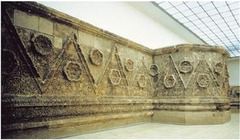
|
Frieze from Umayyad Palace
Mashta, Jordan 740-750 -Umayyad caliphs maintained power and constructed numerous palaces -frieze of animals -in private architecture caliphs were not restricted to the same things as in holy places |
|

|
Doors with relied panels (Genesis, left door; life of Christ, right door), commissioned by Bishop Bernward for Saint Michael's
Hildesheim, Germany 1015 Bronze -15 feet tall -these doors lead into Saint Michael's -the left side is the sin of man, starting with the creation of Eve and ending with the murder of Adam and Eve's son Abel -the right side is the life of Jesus, starts at the bottom, ending with the Resurrection -basically tells the story of why you should go to church |
|
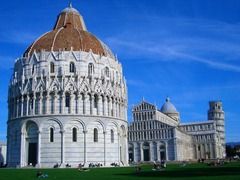
|
Cathedral Complex (looking northeast)
Pisa, Italy Cathedral begun in 1063, bapistery begun in 1153, campanile begun in 1174 -built at many different times, compilation of multiple styles -parts, like roof, resemble early basilicas -Romanesque church -Leaning Tower of Pisa, could have fixed it, decided not to for tourism |

